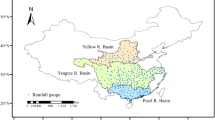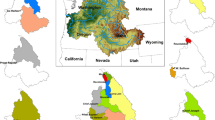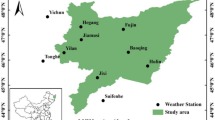Abstract
Five downscaling techniques, namely the statistical downscaling model, the automated statistical downscaling method, the change factor (CF) method, the advanced CF method, the Weather generator (LarsWG5) method, are applied to the upstream basin of the Huaihe River. Changes in regional climate scenarios and hydrology variables are compared in future periods to investigate the uncertainty associated with the downscaling techniques. Paired-sample T test is applied to evaluation the significant of the difference of the means between the observed data and the downscaled data in the future. The Xinanjiang rainfall–runoff model is employed to simulate the rainfall–runoff relation. The results demonstrate that the downscaling techniques utilized herein predict an increased tendency in the future. The increases range of maximum temperature (Tmax) is between 3.7 and 4.7 °C until the time period of 2070–2099 (2080s). While, the increases range of minimum temperature (Tmin) is between 2.8 and 4.9 °C until 2080s. The research presented herein determined that there is an increase predicted for the peaks over threshold (discussed in the paper) and a decrease predicted for the peaks below the threshold (discussed in the paper) in the future, which illustrates that the temperature would rise gradually in the future. Precipitation changes are not as obvious as temperatures changes and tend to be influence by the season. Most downscaling techniques predict increases, and others indict decreases. The annual mean precipitation range changes between 3.2 and 53.3 %, and moreover, these changes vary from season to season.










Similar content being viewed by others
References
Arora VK, Boer GJ (2001) Effects of simulated climate change on the hydrology of major river basins. J Geophys Res 106(D4):3335–3348
Bárdossy A, Stehlík J, Caspary H-J (2002) Automated objective classification of daily circulation patterns for precipitation and temperature downscaling based on optimized fuzzy rules. Clim Res 23:11–22
Bastola S, Murphy C, Sweeney J (2011) The role of hydrological modelling uncertainties in climate change impact assessments of Irish river catchments. Adv Water Resour 34(5):562–576
Boé J, Terray L, Habets F, Martin E (2006) A simple statistical-dynamical downscaling scheme based on weather types and conditional resampling. J Geophys Res Atmos 111(D23). doi: 10.1029/2005JD006889
Charlton R, Fealy R, Moore S, Sweeney J, Murphy C (2006) Assessing the impact of climate change on water supply and flood hazard in Ireland using statistical downscaling and hydrological modelling techniques. Clim Chang 74(4):475–491
Chen J, Brissette FP, Leconte R (2011a) Uncertainty of downscaling method in quantifying the impact of climate change on hydrology. J Hydrol 401(3–4):190–202
Chen J, Brissette FP, Poulin A, Leconte R (2011b) Overall uncertainty study of the hydrological impacts of climate change for a Canadian watershed. Water Resour Res 47(12):W12509
Christensen NS, Wood AW, Voisin N, Lettenmaier DP, Palmer RN (2004) The effects of climate change on the hydrology and water resources of the Colorado river basin. Clim Chang 62(1):337–363
Chu J, Xia J, Xu CY, Singh V (2010) Statistical downscaling of daily mean temperature, pan evaporation and precipitation for climate change scenarios in Haihe River, China. Theor Appl Climatol 99(1):149–161
Conway D, Jones PD (1998) The use of weather types and air flow indices for GCM downscaling. J Hydrol 212–213:348–361
Diaz-Nieto J, Wilby R (2005) A comparison of statistical downscaling and climate change factor methods: impacts on low flows in the River Thames, United Kingdom. Clim Chang 69(2–3):245–268
Dibike YB, Coulibaly P (2005) Hydrologic impact of climate change in the Saguenay watershed: comparison of downscaling methods and hydrologic models. J Hydrol 307(1–4):145–163
DÍEz E, Primo C, GarcÍA-Moya JA, GutiÉRrez JM, Orfila B (2005) Statistical and dynamical downscaling of precipitation over Spain from DEMETER seasonal forecasts. Tellus A 57(3):409–423
Ebrahim GY, Jonoski A, Griensven Av, Baldassarre GD (2012) Downscaling technique uncertainty in assessing hydrological impact of climate change in the Upper Beles River Basin, Ethiopia. Hydrol Res 43. doi:10.2166/nh.2012.037
Enke W, Spekat A (1997) Downscaling climate model outputs into local and regional weather elements by classification and regression. Clim Res 8:195–207
Feddersen H, Andersen U (2005) A method for statistical downscaling of seasonal ensemble predictions. Tellus A 57(3):398–408
Gao C, Gemmer M, Zeng X, Liu B, Su B, Wen Y (2010) Projected streamflow in the Huaihe River Basin (2010–2100) using artificial neural network. Stoch Environ Res Risk Assess 24(5):685–697
Gleick PH (1989) Climate change, hydrology, and water resources. Rev Geophys 27(3):329–344
Gordon C, Cooper C, Senior CA, Banks H, Gregory JM, Johns TC, Mitchell JFB, Wood RA (2000) The simulation of SST, sea ice extents and ocean heat transports in a version of the Hadley Centre coupled model without flux adjustments. Clim Dyn 16(2–3):147–168
Hargreaves GH, Samani ZA (1982) Estimating potential evapotranspiration. J Irrig Drain Div 108(3):225–330
Hay LE, Wilby RL, Leavesley GH (2000) A comparison of delta change and downscaled GCM scenarios for three mountainous basins in the United States. JAWRA J Am Water Resour Assoc 36(2):387–397
Haylock MR, Cawley GC, Harpham C, Wilby RL, Goodess CM (2006) Downscaling heavy precipitation over the United Kingdom: a comparison of dynamical and statistical methods and their future scenarios. Int J Climatol 26(10):1397–1415
Herrmann MJ, Somot S (2008) Relevance of ERA40 dynamical downscaling for modeling deep convection in the Mediterranean Sea. Geophys Res Lett 35(4). doi:10.1029/2007GL032442
Hessami M, Gachon P, Ouarda TBMJ, St-Hilaired A (2008) Automated regression-based statistical downscaling tool. Environ Model Softw 23(6):813–834
Huth R (1997) Potential of continental-scale circulation for the determination of local daily surface variables. Theor Appl Climatol 56(3):165–186
Khan MS, Coulibaly P, Dibike Y (2006a) Uncertainty analysis of statistical downscaling methods. J Hydrol 319(1–4):357–382
Khan MS, Coulibaly P, Dibike Y (2006b) Uncertainty analysis of statistical downscaling methods using Canadian Global Climate Model predictors. Hydrol Process 20(14):3085–3104
Kiely G (1999) Climate change in Ireland from precipitation and streamflow observations. Adv Water Resour 23(2):141–151
Leavesley GH (1994) Modeling the effects of climate change on water resources—a review. Clim Chang 28(1):159–177
Lü H, Hou T, Horton R, Zhu Y, Chen X, Jia Y, Wang W, Fu X (2013) The streamflow estimation using the Xinanjiang rainfall runoff model and dual state-parameter estimation method. J Hydrol 480:102–114
Ludwig R, May I, Turcotte R, Vescovi L, Braun M, Cyr J-F, Fortin L-G, Chaumont D, Biner S, Chartier I, Caya D, Mauser W (2009) The role of hydrological model complexity and uncertainty in climate change impact assessment. Adv Geosci 21:63–71
Maurer E (2007) Uncertainty in hydrologic impacts of climate change in the Sierra Nevada, California, under two emissions scenarios. Clim Chang 82(3):309–325
Merritt WS, Alila Y, Barton M, Taylor B, Cohen S, Neilsen D (2006) Hydrologic response to scenarios of climate change in sub watersheds of the Okanagan basin, British Columbia. J Hydrol 326(1–4):79–108
Minville M, Brissette F, Leconte R (2008) Uncertainty of the impact of climate change on the hydrology of a nordic watershed. J Hydrol 358(1–2):70–83
Najac J, Lac C, Terray L (2011) Impact of climate change on surface winds in France using a statistical-dynamical downscaling method with mesoscale modelling. Int J Climatol 31(3):415–430
Nakicenovic N, Alcamo J, Davis G, de Vries B, Fenhann J, Gaffin S, Gregory K, Grubler A, Jung TY, Kram T, La Rovere EL, Michaelis L, Mori S, Morita T, Pepper W, Pitcher HM, Price L, Riahi K, Roehrl A, Rogner H-H, Sankovski A, Schlesinger M, Shukla P, Smith SJ, Swart R, van Rooijen S, Victor N, Dadi Z (2000) Special report on emissions scenarios: a special report of working Group III of the Intergovernmental panel on climate change
Pinto JG, Neuhaus CP, Leckebusch GC, Reyers M, Kerschgens M (2010) Estimation of wind storm impacts over Western Germany under future climate conditions using a statistical–dynamical downscaling approach. Tellus A 62(2):188–201
Pope VD, Gallani ML, Rowntree PR, Stratton RA (2000) The impact of new physical parametrizations in the Hadley Centre climate model: HadAM3. Clim Dyn 16(2–3):123–146
Qi ZF, Ye XY, Zhang H, Yu, ZL (2013) Land fragmentation and variation of ecosystem services in the context of rapid urbanization: the case of Taizhou city, China. Stoch Environ Res Risk Assess 1–13. doi:10.1007/s00477-013-0721-2
Quintana Seguí P, Ribes A, Martin E, Habets F, Boé J (2010) Comparison of three downscaling methods in simulating the impact of climate change on the hydrology of Mediterranean basins. J Hydrol 383(1–2):111–124
Racsko P, Szeidl L, Semenov M (1991) A serial approach to local stochastic weather models. Ecol Model 57(1–2):27–41
Risbey JS, Entekhabi D (1996) Observed Sacramento Basin streamflow response to precipitation and temperature changes and its relevance to climate impact studies. J Hydrol 184(3–4):209–223
Semenov MA, Brooks RJ, Barrow EM, Richardson CW (1998) Comparison of the WGEN and LARS-WG stochastic weather generators for diverse climates. Clim Res 10(2):95–107
Singh K, Xie M (2008) Bootstrap: a statistical method. www.stat.rutgers.edu/~mxie/rcpapers/bootstrap.pdf
Steele-Dunne S, Lynch P, McGrath R, Semmler T, Wang S, Hanafin J, Nolan P (2008) The impacts of climate change on hydrology in Ireland. J Hydrol 356(1–2):28–45
Tatli H, Nüzhet Dalfes H, Sibel Menteş Ş (2004) A statistical downscaling method for monthly total precipitation over Turkey. Int J Climatol 24(2):161–180
Vicuna S, Maurer EP, Joyce B, Dracup JA, Purkey D (2007) The sensitivity of California water resources to climate change scenarios. JAWRA J Am Water Resour Assoc 43(2):482–498
Wang T, Istanbulluoglu E, Lenters J, Scott D (2009) On the role of groundwater and soil texture in the regional water balance: an investigation of the Nebraska Sand Hills, USA. Water Resour Res 45(10):W10413
Whitfield PH, Cannon AJ (2000) Recent variations in climate and hydrology in Canada. Can Water Resour J 25(1):19–65
Wilby RL, Wigley TML (1997) Downscaling general circulation model output: a review of methods and limitations. Prog Phys Geogr 21(4):530–548
Wilby RL, Hay LE, Leavesley GH (1999) A comparison of downscaled and raw GCM output: implications for climate change scenarios in the San Juan River basin, Colorado. J Hydrol 225(1–2):67–91
Wilby RL, Dawson CW, Barrow EM (2002) SDSM—a decision support tool for the assessment of regional climate change impacts. Environ Model Softw 17(2):147–159
Wilby RL, Tomlinson OJ, Dawson CW (2003) Multi-site simulation of precipitation by conditional resampling. Clim Res 23(3):183–194
Xu CY (1999) Climate change and hydrologic models: a review of existing gaps and recent research developments. Water Resour Manag 13(5):369–382
Yue W, Liu Y, Fan P, Ye X, Wu C (2012) Assessing spatial pattern of urban thermal environment in Shanghai, China. Stoch Environ Res Risk Assess 26(7):899–911
Zhao RJ (1992) The Xinanjiang model applied in China. J Hydrol 135(1–4):371–381
Zhao RJ, Zhang YL, Fang LR (1980) The Xinanjiang model. In: Hydrological forecasting proceedings of oxford symposium IASH, vol 129, pp. 351–356
Acknowledgments
This research is supported by the Program for National Basic Research Program of China (2013CBA01806, 2010CB951101), the Major Program of National Natural Science Foundation of China (51190090), NSSF (41371049, 50939006), the Program for Graduate Education Innovation Project in Jiangsu Province (CXLX13_239) and IWHRSKL-201213. The authors wish to acknowledge gratefully Kendra M. Dresback of University of Oklahoma for revising the grammar of this paper.
Author information
Authors and Affiliations
Corresponding author
Rights and permissions
About this article
Cite this article
Ouyang, F., Lü, H., Zhu, Y. et al. Uncertainty analysis of downscaling methods in assessing the influence of climate change on hydrology. Stoch Environ Res Risk Assess 28, 991–1010 (2014). https://doi.org/10.1007/s00477-013-0796-9
Published:
Issue Date:
DOI: https://doi.org/10.1007/s00477-013-0796-9




